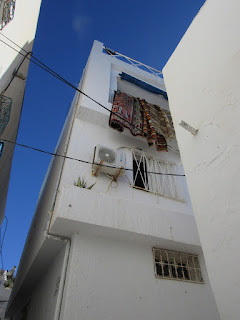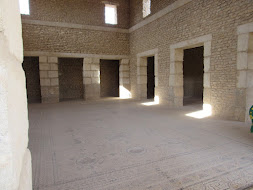Hammamet is an historical city on the Mediterranean Sea that goes back to the 2nd century colonizing Romans and the 8th century Arabs when they swept across North Africa. The Arabs controlled this area until the Turks arrived in 1534 and stayed for the next 300 years except when the Spanish ruled for 60 years starting in 1601.
During World War II, Hammamet became one of the headquarters of the Nazi general Erwin Rommel. Former Italian prime minister Bettino Craxi moved to Hammamet in 1994 as a fugitive. He died and was buried here in 2000.
 The reasons why Hammamet has long been a popular place are the thermal baths, the fresh seaside air, and the fertile land. I can attest to the fresh air. It seems to cleanse the soul especially in the moderate January sunshine! The beautiful beaches on the Mediterranean Sea are accessible to all although there are many private beaches as well.
The reasons why Hammamet has long been a popular place are the thermal baths, the fresh seaside air, and the fertile land. I can attest to the fresh air. It seems to cleanse the soul especially in the moderate January sunshine! The beautiful beaches on the Mediterranean Sea are accessible to all although there are many private beaches as well.
Today,
Hammamet is a popular tourist town with hotels, discos, lounges,
alcohol, night life, and a theatre (built in the 1950s) all that don't
seem to belong in an Arab country. In short, Hammamet is known as a
"party town" to the point that other Tunisians don't believe people
really live here. In fact, over 100,000 people reside here, but the
summertime tourists can double, triple, and even quadruple the
population. Tunisia is one of the most progressive Arab countries in the
world, and Hammamet attracts tourists--especially jet setters.
Migrants from the southern region of the country have come here to find employment. So suburbs are being built out from the city center even though the central city is a vibrant and bustling place. Many Italians also retire here and live a good and inexpensive life.



 During the 13th century, walls like this one were built around the town and in the 15th century came the medina. As with other medinas, they are comprised of homes, souks (market shops), a Mosque, and a kasbah (military fort). Each medina in each city is different. Hammamet's medina streets are narrow, more like alleyways. The buildings are whitewashed and trimmed with a brilliant sky blue color.
During the 13th century, walls like this one were built around the town and in the 15th century came the medina. As with other medinas, they are comprised of homes, souks (market shops), a Mosque, and a kasbah (military fort). Each medina in each city is different. Hammamet's medina streets are narrow, more like alleyways. The buildings are whitewashed and trimmed with a brilliant sky blue color. 
Shopkeepers keep an eye on passersby as potential customers. Then they almost trap you and aggressively start the bargaining process by pushing their wares on you if you show even the slightest interest. It's really too intimidating for me. I don't like to bargain, and I tend to limit my buying. But this was the way it was in all the cities we visited in Tunisia. I had a brief encounter here with a seller that wasn't at all pleasant.
Hammamet is known for its jasmine and there's plenty of it for sale in the souks as flowers and as lotion. A very aggressive shopkeeper tried to sell me a tube of it along with the two small ceramic bowls that I wanted for 50 dinars (equivalent to $16.66). He gave me a sample of the lotion to further lure me in my purchases, but I turned him down. All I wanted were the two bowls, so I took my money back from his hand. Then he agreed to sell the bowls for 20 dinars ($6.66). He even looked in my wallet to tell me that I had 20 dinars sitting there!
The trick to bargaining is for both parties, the seller and the buyer, to feel good at the end of the transaction. In this little encounter, neither of us was happy, and the seller said so under his breath, which I ignored. I had all I could do to get away.
In another of my encounters I wanted one copper plate (the size of a saucer). The seller offered to put my name on it in Arabic. I agreed. I asked him the price and he didn't bargain; he said it was 5 dinars ($1.66). I gave him a 20-dinar bill, and he gave me back 10 dinars. I asked for the other 5 dinars, and he wouldn't give it to me. Instead, he held out a 10 dinar note saying that is what I gave him. So the lesson I learned in the souks (a $1.66 lesson) is to hold my money until the seller is ready to make the transaction.
Tons of cats patrol the neighborhood for rodents when they are not lounging in the sun or begging for food from passersby. (One of the women in our group spent a lot of time feeding the cats on the streets from the scraps of our meals. She was like St. Francis of Assisi taking care of them!)

The great Mosque sits proudly in the Medina. Five times a day the people are called to prayer in a chant that has been recorded and projected from the single minaret or tower. This call to prayer makes cities and towns enchanting and exotic places.

A cool café. I looked for it after our formal tour but couldn't find it. Instead, I had coffee on the street with a group of friends.
Doors are fascinating in Tunisia. Here are my favorites in Hammamet. This one is my favorite style where it incorporates a garden. The one on the left below is the entrance to the women's hammam, a bathhouse where they scrap you down and heat you up for a skin treatment that is relaxing and lasts about a month. The one on the right is a residence. The left knocker at the top of the door is for women and the one on the right is for men. They emit different sounds so those inside have an idea of who to expect. Sometimes there is a knocker on the lower right of the door that children use to announce their presence.
Tourism is king in Hammamet to the point that in the high season the streets are blocked with traffic jams of cars.
 This sculpture of the three mermaids welcomes visitors to this beautiful seaside town. I would come back here for a January vacation it is so appealing and generally inexpensive.
This sculpture of the three mermaids welcomes visitors to this beautiful seaside town. I would come back here for a January vacation it is so appealing and generally inexpensive. Street scenes
Hammamet is a vibrant and busy city. It has lots of shops with lots of colors. Here are some street scenes taken from our tour bus as we passed them.


Taxis seem to be a favored mode of transportation in Tunisian towns. Here they are awaiting their next gig. They are yellow with a lit marker on the passenger's side. If it is green, the taxi is busy. If it is red, it's available for hire.






I would return to Hammamet for a January vacation where the sun is out but the winter heat is not as intense as the summer heat. And, the tourists are minimal. Our guide said that there are many Airbnbs operating all year round. And, the town is about an hour away from Carthage and the Tunis-Carthage International Airport. A fast and comfortable coach service runs from the Tunis city bus station to Hammamet, so you must take a taxi from the airport to Tunis (about 30 dinars or $10) and catch the bus to Hammamet. Taxis are always available in town.
Resources
Hammamet -- https://en.wikipedia.org/wiki/Hammamet%2C_Tunisia
Turks in Tunisia -- https://enwikipedia.org/wiki/Turks_in_Tunisia



























































